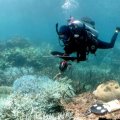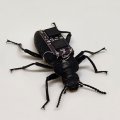The world’s forefront scientists simulating earth processes are meeting in Brisbane today and tomorrow to discuss a collaborative venture to construct a solid earth simulator or virtual observatory using advanced supercomputer simulation models.
The meeting is the 3-rd international working group meeting for the APEC Cooperation for Earthquake Simulation (ACES), an international cooperation headquartered at The University of Queensland. The meeting is focused on collaborative work to develop advanced computer simulation models and software for earth dynamics ranging from the global scale to the micro-scale.
Professor Peter Mora, Executive Director of ACES and founding Director of the newly established Australian Computational Earth Systems Simulator Major National Research Facility said the simulation models being developed by the ACES group represent a new way of science which may unlock some of the mysteries in understanding the earth’s dynamics while also providing a driver for innovation in the earth resources sector.
The ACES cooperation was founded in 1998 and has grown in size to include over 40 leading research centers and agencies from Australia, China, Japan and USA including NASA JPL, Tokyo University, The University of Queensland and Beijing University.
ACES links major new complementary national efforts to develop computer simulation models for the earth including NASA JPL’s QuakeSim project, Japan’s Solid Earth Simulator Project within Japan’s Earth Simulator initiative which constructed the world’s fastest supercomputer, and a new major national research facility in Australia, the Australian Computational Earth Systems Simulator initiative which aims to model earth processes from the crustal to global scale.
Dr. Andrea Donnellan of JPL, principle investigator of NASA’s QuakeSim project and US International Science Board Member for ACES said the simulation models being developed represent a vital step toward eventual earthquake forecasting. “The deformation of Earth’s crust and the interaction between quake faults is a complex 3-D process happening on timescales of minutes to thousands of years,” she said. “Studying it requires sophisticated simulation models and high-performance supercomputers. The availability of space-based data and our current limited understanding of quake processes make this an ideal time to develop a system for studying deformation processes such as tectonics, quakes and volcanoes.”
Professor John Rundle, founding Director of a new Computational Science Centre at the University of California in Davis said the simulation models were providing a means to understand complex phenomena in the earth in a way never before possible. This is part of an exciting new frontier in science called complex systems science, he said.
Hans Mühlhaus, Acting CEO of the ACcESS Major National Research Facility said the computer models being developed are important not only for gaining new understanding of earth dynamics and geohazards, but also because they provide a means for high tech software solutions and innovation in the mining and minerals industries.
For more information see:
http://www.quakes.uq.edu.au/ACES/3rdACES-WGM.html
http://www.aces/org/au
http://pat.jpl.nasa.gov/public/RIVA/ (NASA QuakeSim project web pages).
.jpg)


